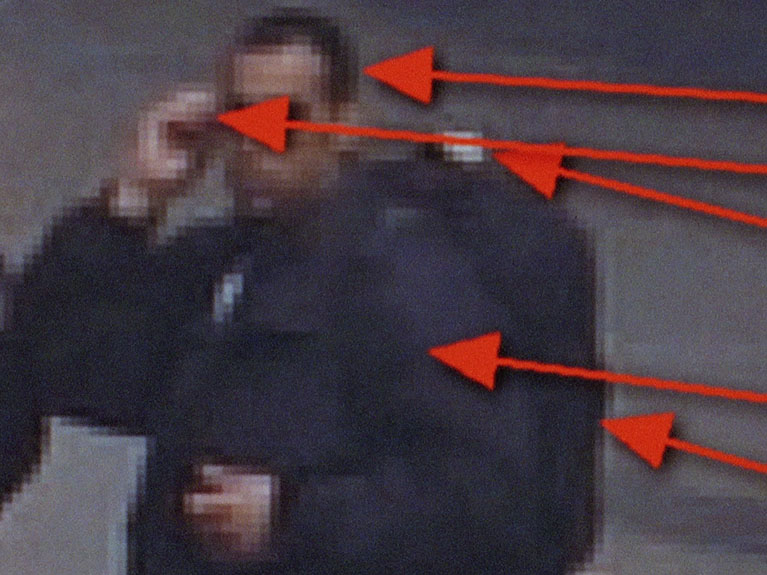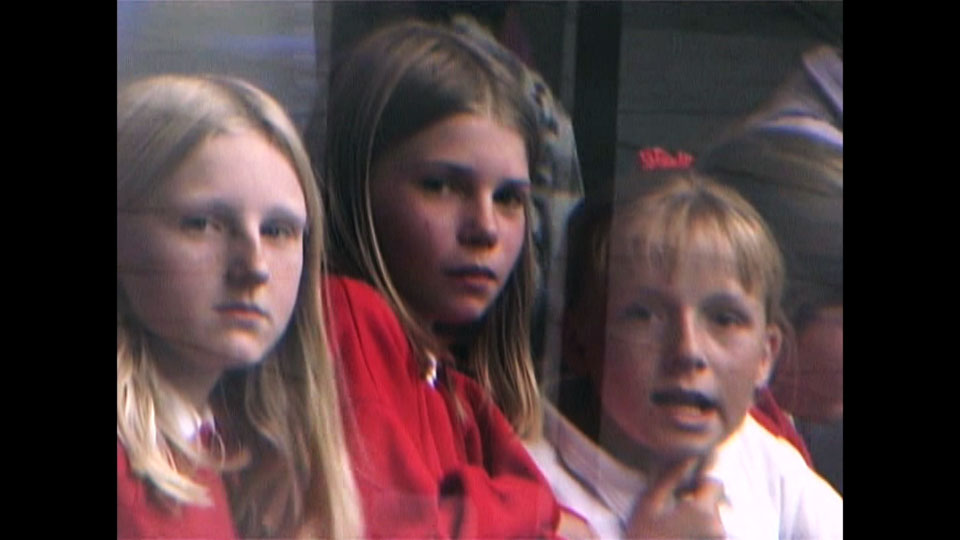Saturday October 14, 2017
7:30 Doors, Screening 8:00pm
$8/$5 members + students
@CineCycle, 129 Spadina Avenue
Program Notes
How Little We Know of Our Neighbours by Rebecca Baron (49 minutes 2005)
An eccentric essayist, American native Rebecca Baron continues her questioning forays into pictures with her third and longest movie-to-date, How Little We Know of Our Neighbours. It begins with surveillance camera footage from the National Museum of Media in Bradford, England, which swoops and zooms, collecting casual encounters on the nearby sidewalks. Inside the museum, a suite of photographers occasionally take aim at the art, but more often at each other, as if the visitors were on display instead of the art. The museum frames a question the movie asks again and again: how do we look? And how does our looking change what we are seeing?
Susan Sontag suggested that a tourist takes pictures in order to protect themselves from the shock of new experiences. Here, an artist is someone who takes pictures of tourists making pictures, another form of the protection racket.
In January 1937 a small clutch of UK folks dedicated themselves to a new form of domestic tourism, dubbing themselves the Mass Observation Movement. They were concerned with the truth in a self-styled “campaign”aimed at “an anthopology of ourselves” (by which they meant everyone else) and the “realities of the everyday.” No detail was too small to be noted. Why did they smile and what were they wearing? Were the windows open or closed? How many times did they say thank you? Stopwatches were taken to the cinema so that laugher could be timed. Or later, in the bar, how long did it take to drink a pint? Or visit the washroom? Journals were filled, photographs taken, monthly questionaires dutifully filed.
They imagined that the true nature of the UK’s repressed society would make itself evident if only enough facts were conjured. The belief in a utopian science underpinned their efforts, along with an understanding that objects or behaviours were the concrete realizations of inner states.
Rebecca Baron’s first two movies were based on still photos – the Arctic expedition remapping of The Idea of North (1995) and the personal/colonial Vietnam essay Okay Bye-Bye (1998), so it’s little surprise that she turns to the rich photo archives of the Mass Observation Movement. The pictures are casual and studied, almost invariably shot in public, often showing congregations of various sizes. Never less than fascinating. In all of this the artist implicates the viewer, not content to stay at a smugly safe distance, the lure of these old pictures is tangible, and the artist invites us not only to see them, but to see ourselves seeing.
The gendered gaze of the camera’s technological looking is not lost here, behind the camera are often men seeking picture trophies of women or even girls, filling albums with their booty. Here the artist underlines the way patriarchy resides in the look, and in the new anxiety around the interval between work and sleep, and the need to fill that undisciplined space with surveillance and accounting records. Because one of the key figures in the movement was Tom Harrison, an anthropologist, the link between colonialism and the new technology of the handheld camera is made explicit. The camera brings with it the demand to strike a pose without end, to put on a public face, to wear the suit of persona, attitude, to invent a public self and a private one. Francis Galton, the father of eugenics, used the camera to further his theory of racial hierarchy and white supremacy. This domestic surveillance movement was a way to bring colonialism home to roost.
Interwoven with historical notes and interviews are the artist’s shootings in contemporary England. A sullen smoker puffs with his arm up between the legs of his girlfriend. A drunk teen strips, another licks the camera lens. A boy stands dazed in a frieze of strangers. How are the artist’s easvesdropping and snoopings different from the underground archivists of Mass Observation, except that one is official, and the other unofficial? The movie itself, as spectacle, time capsule and peepshow, might offer the safe remove any entertainment conjures, but it pushes and pulls at this insulation, finding in the MO’s dedicated snoopsters the roots of our own fascination to keep on watching.
Watching the Detectives by Chris Kennedy (35 minutes silent 2017)
A half-hour meta-doc about the online sleuthing surrounding the bombing of the Boston Marathon in 2013. Imagine Patriot’s Day without Mark Wahlberg leading the charge. Instead, a steadfast group of amateur photo fabulists sift evidence, converting pictures into language.
On April 15, 2015, two powerful home-made bombs went off near the finish line of the Boston Marathon, killing three people, including an eight-year old boy, and injuring hundreds. More than a dozen lost limbs. Most of the runners had finished the race when the first bomb, planted in a garbage can, exploded, followed shortly by the second blast. On the evening of the attack, there were no suspects, though the New York Times reported that police had spoken to a Saudi man who had been injured. Three days later, on April 18, the FBI released photographs of suspects Dzhokhar Tasrnaev and Tamerlan Tsarnaev.
In that three-day period the internet was filled with home-brewed speculation around the killer’s identities, particularly in the social media hothouses of Reddit and 4chan – sites where users can interact with photos and texts. Kennedy creates a compelling collage of screen grabs as armchair detectives zero in on various details of the publically available video (from police and street cams) and offer their speculations about who might be responsible. Anyone with a backpack is instantly suspect, and of course anyone who is not white.
What comes into focus is the look itself, the images create a picture of their viewers. The racist assumptions and rampant speculation around missing student Sunil Tripathi spin together into a cocktail of collective hysteria that creates a group identity, a cohesion that relies on a common cause/enemy. Here are the mechanics of the mob unpacked in a crisp sequencing that drives us towards the movie’s wandering close, the camera floating through the emptied streets, looking for a face, a name, another clue to follow.
If an identity quest is central to the movie’s narrative, the eventual killing/capture of the Tsarnaev brothers lies outside the plot, along with the reasons for the bombing – America’s ongoing war against Palestine, and its colonial forays into Iraq, Afghanistan and Kuwait. Reports on the bombing by Al-Jazeera and other agencies in the Middle East named the attack as “blowback” for American foreign policy and the relentless killing it delivers so reliably to Arab/Muslim citizens abroad. The political reality of this 20-21st century crusade is crushingly evident in so much of the world, though too often lacking on these shores.
Screening Intro
Good evening and welcome to Pleasure Dome. Our next show in the fall line up will happen right here in Cinecycle in two weeks and feature Francesco Gagliardi. Philosopher, performance artist, movie maker. Is there anyone in the city who has a deeper relationship and understanding of the work of Gertrude Stein?
I’d like to acknowledge that we are on the land of the Huron-Wendat, the Seneca, Anishinaabe, Haudenosaunee and most recently the Missaugas of the New Credit. For anyone wanting to know more I cannot recommend enough Arthur Manuel’s brilliant Unsettling Canada.
We’re going to look at two movies tonight. The first is by American essay-filmmaker Rebecca Baron. She was born in 1968 in Baltimore and eventually moved to New York City where she worked at Pennebaker and Associates – maestros of cinema verite right – and on nights and weekends she put together her first movie. It was called The Idea of North, you can hear in the title an echo of Glenn Gould’s celebrated experimental audio doc, but in this case she’s using the recovered photos of S. A. Andrée’s failed 1897 expedition to reach the North Pole in a hydrogen balloon. Three polar explorers wind up trapped, marooned on an ice floe a hundred years ago. After this movie she enrolled at the University of California, San Diego where she continued her interest in how history is made of what remains. What do we do with our remains. How does that shape not only our view of the past, but the way we understand ourselves, right now?
At the end of her school tenure she finishes up another unusual essay-doc OK Bye Bye which looks at the war they called in Vietnam The American War, and brings it home, talking to folks in her new home of Southern California. Tonight’s movie, which finds her skulking through the UK, took her eight years to make. It remains the longest, perhaps the most complicated of all of her excellent movies.
The second movie is by local artist, LIFT director and Wavelengths programmer Chris Kennedy.
Chris started making movies that told stories in high school before going to Queen’s University where his early dreams were derailed and he became interested in fringe medias of every stripe. He started making movies again – could we call it a second beginning –with an uncut roll of regular 8 film and then a lyrical portrait of his grandmother. He came to Toronto and saw every movie ever made, and his seeing raised at least this question: Having watched too many movies, how can I begin something I could call my own, that feels like me, or at least, my sensibility, my point of view? What is my point of view.
Chris went to the San Francisco Art Institute, and despite limited funds, created a number of 16mm shorts including what might be his most well-known movie, Tape Film, in which the artist tapes himself into a corner. A hand-processing workshop by Janis Crystal Lipzin allowed him to realize not only cost-effective makings, but also the delirious chemical palette of the movie. A distinct formalism took up residence. There were new geometries that could be followed or betrayed, broken even, but always pointed at, as a kind of reference guide.
The consolations of order arrive via trains and bridges in Gladstone, in the above ground upside-down rail train in Phantoms and Shuh Schnell Service. There was an homage to Sol LeWitt, maestro of the grid, and even a pair of grid movies, one shot outside San Francisco, the other on the Credit River in Mississauga. Though just when he seemed to have committed himself to a modernist formalism, he released lay claim to an island, a look at the 1969 First Nations occupation of Alcatraz Prison. It’s been a few years since he’s finished a movie, though he’s helped to make a child in the intervening years, I’m guessing that’s slowed things down a little, perhaps even provoked some questions around looking and identity.
Rebecca’s movie is 50 minutes long and it will be followed by Chris’s 35-minute silent movie, oh yes, a silent movie, the kind of silent movie that happens without sound. I hope you enjoy.


